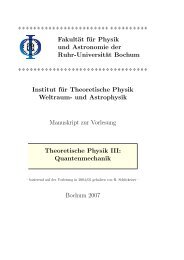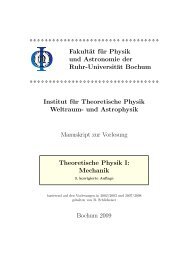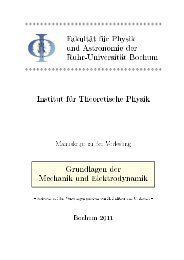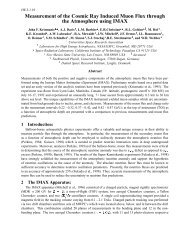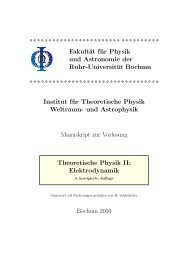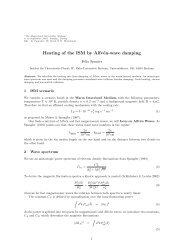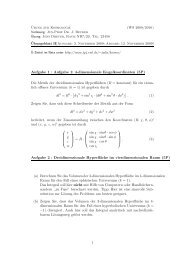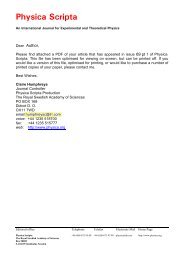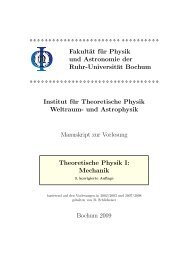pdf here - Theoretische Physik IV - Ruhr-Universität Bochum
pdf here - Theoretische Physik IV - Ruhr-Universität Bochum
pdf here - Theoretische Physik IV - Ruhr-Universität Bochum
Create successful ePaper yourself
Turn your PDF publications into a flip-book with our unique Google optimized e-Paper software.
A. Solitary wave solution<br />
The solitary wave solution(s) of Eq.(31) may be cast in the form<br />
w<strong>here</strong><br />
d'<br />
(1) 2<br />
=<br />
C <br />
d 6B '(1)2 ' (1)2 + 2A <br />
6U 0<br />
C '(1) ;<br />
C<br />
= C<br />
6B '(1)2 (' (1) ' 1 )(' (1) ' 2 ); (33)<br />
' 1 =<br />
1 C<br />
<br />
A<br />
p <br />
; ' 2 = 1 <br />
A + p <br />
; and = A 2 + 6U 0 C: (34)<br />
C<br />
We are looking for stationary soliton solutions, whose pro…le vanishes in the unperturbed<br />
region. For this reason, we have used ' ! 0 and d'=d ! 0 at jj ! 1: After integrating<br />
Eq. (33) we then obtain positive and negative soliton solutions [26], respectively<br />
' (1)<br />
+ =<br />
' (1) =<br />
(6U 0 =C)<br />
; (35)<br />
' 1 sinh 2 1<br />
2p<br />
U0 =B ' 2 cosh 2 1<br />
2p<br />
U0 =B<br />
' 2 sinh 2 <br />
1<br />
2p<br />
U0 =B<br />
(6U 0 =C)<br />
<br />
' 1 cosh 2 <br />
1<br />
2p<br />
U0 =B<br />
: (36)<br />
To examine the soliton propagation in our e-p-i plasma, A must be in the order of " and<br />
should be positive. The range of the propagation speed (), which gives small A " and<br />
positive ; is depicted in Fig. 3(a, b) - 5(a, b) for di¤erent values of and i . It is seen<br />
that for small = 0:1, the range of is narrow for both low and high i . Increasing to<br />
0:5, one encounters only supersonic solitons. For = 0:9 neither subsonic nor supersonic<br />
solitons can propagate.<br />
In Fig.<br />
6, we have numerically analyzed the Sagdeev potential (32) and investigated<br />
how the propagation speed (), the electron-to-ion temperature ratio ( i ) and the positronto-electron<br />
density ratio () change the pro…le of the potential well. It turns out that an<br />
increase of the propagation speed (the electron-to-ion temperature ratio i and positron-toelectron<br />
density ratio ) leads to an increase (a decrease) of the potential depth, but decrease<br />
(increase) of the potential amplitude. Figure 7 shows the dependence of the compressive<br />
and rarefactive solitary pulse on the propagation speed (), the electron-to-ion temperature<br />
ratio ( i ) and the positron-to-electron density ratio (). It is obvious that faster positive<br />
11



